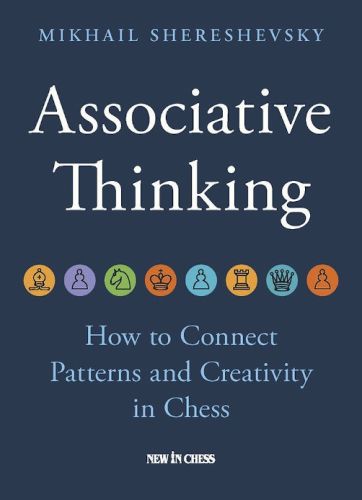Article Number
LXSHEATG
Author
Associative Thinking (hc)
Attributes
304 pages, hardback, New in Chess, 1. edition 2025
This new book by Mikhail Shereshevsky, one of the most respected chess trainers in the world, is about a very important but little-explored topic: associative thinking. How can a modern chess student avoid drowning in the flood of information? The answer is to stop mechanically memorizing moves and turn on your curiosity. Try to create a vivid image of the technique you are studying and remember it as an association!
During a game of chess, we have associations all the time. We are not talking about specific pawn structures, but about more abstract things. What is the best interaction between knight and pawn? Where should the rook be placed behind the passed pawn or to the side? On which squares should you place your pawns when you have a bishop against a knight? Generations of chess players before us have answered these and similar questions.
Shereshevsky clearly shows that studying the games of great chess players will help you to improve your associative thinking, especially when the comments come from the players themselves. The author pays special attention to such outstanding grandmasters as Ulf Andersson, Anatoly Karpov, Vladimir Kramnik, and Magnus Carlsen.
As with all of Shereshevsky’s books, this manual offers supreme examples of chess training excellence. Studying this book will improve your understanding of chess enormously and help you on your way to chess mastery.
Mikhail Shereshevsky (1950) is one of the most respected chess trainers and writers in the world. In 2018, he published the best-selling The Shereshevsky Method to Improve in Chess. His magnum opus, Endgame Strategy, is a must-read for ambitious players. It’s been hailed by superstars like Vladimir Kramnik and Magnus Carlsen as their formative guide to handling the endgame.
During a game of chess, we have associations all the time. We are not talking about specific pawn structures, but about more abstract things. What is the best interaction between knight and pawn? Where should the rook be placed behind the passed pawn or to the side? On which squares should you place your pawns when you have a bishop against a knight? Generations of chess players before us have answered these and similar questions.
Shereshevsky clearly shows that studying the games of great chess players will help you to improve your associative thinking, especially when the comments come from the players themselves. The author pays special attention to such outstanding grandmasters as Ulf Andersson, Anatoly Karpov, Vladimir Kramnik, and Magnus Carlsen.
As with all of Shereshevsky’s books, this manual offers supreme examples of chess training excellence. Studying this book will improve your understanding of chess enormously and help you on your way to chess mastery.
Mikhail Shereshevsky (1950) is one of the most respected chess trainers and writers in the world. In 2018, he published the best-selling The Shereshevsky Method to Improve in Chess. His magnum opus, Endgame Strategy, is a must-read for ambitious players. It’s been hailed by superstars like Vladimir Kramnik and Magnus Carlsen as their formative guide to handling the endgame.
| EAN | 9789083431352 |
|---|---|
| Weight | 500 g |
| Manufacturer | New in Chess |
| Width | 17 cm |
| Height | 23.5 cm |
| Medium | Book |
| Year of Publication | 2025 |
| Author | Mikhail Shereshevsky |
| Language | English |
| Edition | 1 |
| ISBN-13 | 9789083431352 |
| Pages | 304 |
| Binding | hardback |
| Name | New in Chess B.V. |
|---|---|
| Adresse | Rochdalestraat 4 a Alkmaar 1814 TH Niederlande |
| Internet | www.newinchess.com |
| nic@newinchess.com |
007 Foreword
009 Introduction
013 Chapter 1) ‘Masonry’ and the essence of associative thinking
019 Chapter 2) Cooperation between knight and pawn
036 Chapter 3) To hurry or not to hurry?
047 Chapter 4) Benchmarks and errors
061 Chapter 5) Associative thinking in the defence of inferior positions; active or passive defence
073 Chapter 6) Fundamental endgame principles: methods of play
083 Chapter 7) Associative thinking in rook endings
167 Chapter 8) The problem of exchanges in inferior positions
208 Chapter 9) Associative thinking in superior positions
286 Chapter 10) The difference between associative thinking and play in typical positions
299 Acknowledgements
301 Index of names
304 Explanation of symbols
009 Introduction
013 Chapter 1) ‘Masonry’ and the essence of associative thinking
019 Chapter 2) Cooperation between knight and pawn
036 Chapter 3) To hurry or not to hurry?
047 Chapter 4) Benchmarks and errors
061 Chapter 5) Associative thinking in the defence of inferior positions; active or passive defence
073 Chapter 6) Fundamental endgame principles: methods of play
083 Chapter 7) Associative thinking in rook endings
167 Chapter 8) The problem of exchanges in inferior positions
208 Chapter 9) Associative thinking in superior positions
286 Chapter 10) The difference between associative thinking and play in typical positions
299 Acknowledgements
301 Index of names
304 Explanation of symbols
More from New in Chess
-
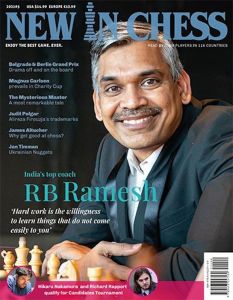 New in Chess Magazine 2022/3€13.99
New in Chess Magazine 2022/3€13.99 -
 New in Chess Magazine 2022/5€13.99
New in Chess Magazine 2022/5€13.99 -
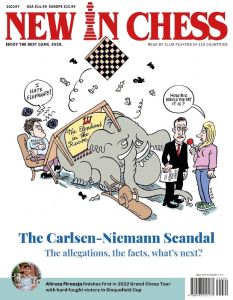 New in Chess Magazine 2022/7€13.99
New in Chess Magazine 2022/7€13.99 -
 New in Chess Magazine 2022/6€13.99
New in Chess Magazine 2022/6€13.99 -
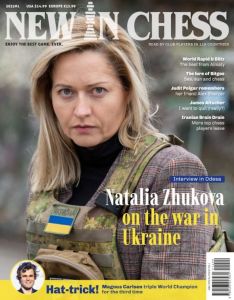 New in Chess Magazine 2023/1€13.99
New in Chess Magazine 2023/1€13.99 -
 New in Chess Magazine 2022/8€13.99
New in Chess Magazine 2022/8€13.99 -
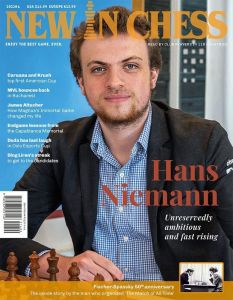 New in Chess Magazine 2022/4€13.99
New in Chess Magazine 2022/4€13.99 - More from New in Chess

